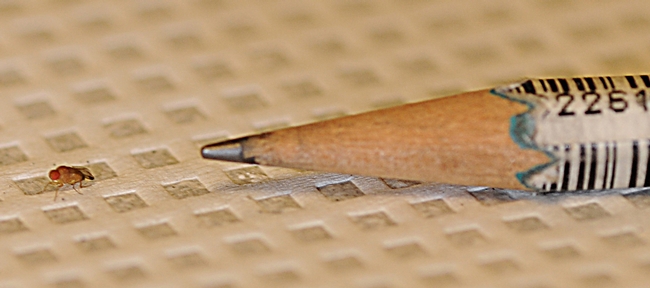- Author: Kathy Keatley Garvey
They're out there, and you don't have to crane your neck to see them.
Some folks mistakenly call them "mosquito hawks" or "mosquito eaters," but they are neither. They are crane flies, members of the family Tipulidae of the order Diptera (flies).
They're everywhere.
We've been seeing the slender, gangly, goofy-looking insects, Tipula oleracea, bump into walls and flower pots. This one (below) glided into the tower of jewels, Echium wildpretii, and just remained there for several minutes.
Lynn Kimsey, director of the Bohart Museum of Entomology and UC Davis distinguished professor of entomology, emphasizes that they don't eat mosquitoes. "In fact, adult crane flies generally don't eat at all," she points out. "Their entire brief adult lives are spent searching for mates and laying eggs." Crane flies are attracted to lights at night and you may find them around your porch light.
"Adult crane flies emerge from the soil beneath turfgrass, pastures and other grassy areas in late summer and fall," according to the UC Statewide Integrated Pest Management Program, part of the UC Agriculture and Natural Resources.. "The adults have very long legs and resemble large mosquitoes. Females mate and lay eggs in grass within 24 hours of emerging. Eggs hatch into small, brown, wormlike larvae that have very tough skin and are commonly referred to as leatherjackets. The leatherjackets feed on the roots and crowns of clover and grass plants during the fall. They spend the winter as larvae in the soil; when the weather warms in spring, they resume feeding. During the day larvae mostly stay underground, but on damp, warm nights they come to the surface to feed on the aboveground parts of many plants. When mature, the larvae are about about 1 to 1½ inch long. Around mid-May they enter a nonfeeding pupal stage and remain just below the soil surface. In late summer, pupae wriggle to the surface and the adults emerge. There is one generation a year."
This one (below) didn't find a mate on the tower of jewels but it did find a towering view. The plant can reach 10 feet in height.
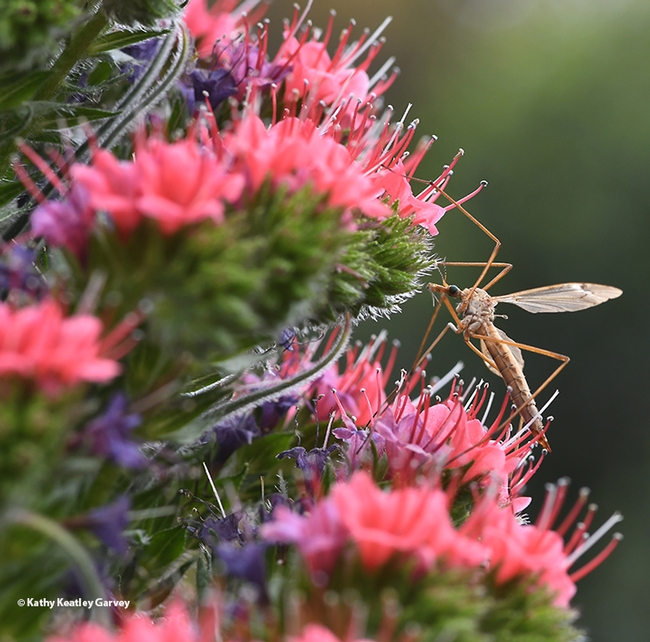
- Author: Kathy Keatley Garvey

No, time's fun when you're studying flies!
Take it from the fly researchers at the University of California, Davis, who will present their work at the Bohart Museum of Entomology open house from 1 to 4 p.m., Saturday, Jan. 12 in Room 1124 of the Academic Surge Building, Crocker Lane. The event, themed “Time's Fun When You're Studying Flies," is free, open to the public, and family friendly.
The open house will showcase botflies, spotted-wing drosophilas, assassin flies, Mediterranean fruit flies, mosquitoes and other members of the Diptera order. Ten scientists, including undergraduate students, graduate students and a visiting scholar, will participate. They will displaying specimens, photos and field equipment and chat with the public.
"Besides checking out the flies, this is also a good time for visitors to inquire about graduate school, ask about starting research projects, and to meet people working in forensics, evolution, agriculture, animal behavior, genetics, geography, and home pests, among other topics," said Tabatha Yang, education and outreach coordinator.
Entomologist Jeff Smith, who curates the Bohart's butterfly and moth section, will be on hand to open the Diptera section. "He will dust off and put on his pest industry hat to talk about those relevant flies," Yang said.
A family craft activity is also planned.
Among the fly researchers participating is fourth-year doctoral candidate Charlotte Herbert Alberts, who studies assassin fly (Asilidae) systematics with major professor Lynn Kimsey, director of the Bohart Museum of Entomology and professor of entomology, UC Davis Department of Entomology and Nematology.
“Assassin flies are one of the only families of flies that are predatory (on other insects) both in their larval and adult stages,” Alberts says.
Other interesting facts about assassin flies:
- They are venomous! Their venom both immobilizes their prey and starts extra-oral digestion.
- They have very fancy facial hair (beards and mustaches) called a mystax, thought to protect their face while they catch and eat their prey.
- Some assassin flies are very selective in their prey choice and may have specialized venom to help them overcome their prey.
- There are more than 7,500 species found all over the world!
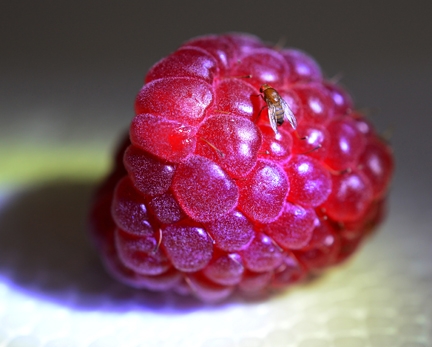
Graduate student Socrates Letana, who also studies with major professor Lynn Kimsey. researches the evolution and diversification of botflies (Oestridae) "in the global mammal host-space with special emphasis on the New World." Part of his research interests include Diptera systematics, biogeography and Southeast Asian biodiversity. He is a research associate with the California State Collection of Arthropods, California Department of Food and Agriculture.
The larvae of botflies are internal parasites of mammals; some species grow in the host's flesh and others within the gut. The Dermatobia hominis is the only species of botfly known to parasitize humans routinely.
Said Letana: "I will be using the pinned and alcohol-preserved materials from the Bohart collection. Also, I am thinking of using my laptop just to show some photos from other museum collections. Some people might be a little squeamish about this group of flies and I will try my best not to scare them away."
UC Davis doctoral student Caroline Wright Larsen of the Graduate Group in Ecology, will discuss her research on non-native tephritid flies, including the Mediterranean fruit fly. She studies with major professor James R. Carey, distinguished professor of entomology. A Bio Boot Camp instructor, part of the Bohart Museum program, she attended Bryn Mawr College outside of Philadelphia for her undergraduate degree, "during which I spent six months living in Kruger National Park, South Africa doing insect biodiversity research." She began her graduate studies in 2011 at U.C. Davis "where I explore the ways in which difficult-to-detect populations of non-native tephritid flies move over space and time in California."
UC Davis undergraduate researcher Cindy Truong of the Joanna Chiu lab, will be showing flies in various life stages and have coloring pages for kids. "We primarily study circadian rhythm, which is the sleep and wake cycle. More specifically we study the mechanisms in which 'clock proteins' go through in order to maintain this cycle." She will expand on "How flies tell time.”
Christine Tabuloc, an undergraduate researcher in the Chiu lab. will discuss her work on fruit flies. "My current focus is to investigate the effects of climatic change on gene expression of an invasive pest and determine whether there is a correlation to resistance and survival," she said. "In addition to pest management research, I am also studying a kinase of a core clock protein in Drosophila melanogaster and hoping to dissect its functional contribution to the molecular oscillator."
Others from the Chiu lab participating will be Yao Cai, a doctoral graduate student who studies genetic mechanisms underlying the regulation of organismal behavior, and undergraduate researcher Christopher Ochoa.
Among the other scientists participating:
- Kathlyne-Inez Soukhaseum of the Frank Zalom lab will talk about her research on the spotted-wing drosophila, Drosophilasuzukii, a major agricultural pest that invaded California in 2008.
- Danielle Wishon, a forsenic entomologist who holds a bachelor's degree in entomology from UC Davis, will discuss bed bugs and other pests.
- Nermeen Raffat, visiting scholar in the Sharon Lawler lab, will focus on mosquito larvae. He is working on "the effect of copper sulphate and other toxicants on the development and anti-predatory behavior of the mosquitoes larvae."
The Bohart Museum, founded in 1946 by UC Davis entomologist Richard “Doc” Bohart (1913-2007), is the home of nearly eight million insect specimens, plus a year-around gift shop and live "petting zoo" that includes Madagascar hissing corckroaces, stick insects, tarantulas and praying mantids. The gift shop is stocked with newly published calendars, books, jewlery, t-shirts, insect-collecting equipment, insect-themed candy, and stuffed animals.
The Bohart Museum is open to the general public Mondays through Thursdays, from 9 a.m. to noon and from 1 to 5 p.m., plus occasional, weekend open houses. Admission is free. The next weekend open house is from 1 to 4 p.m., Sunday, Nov. 18 and centers around urban entomology..
Further information is available on the Bohart Museum website at http://bohart.ucdavis.edu/ or contact (530) 753-0493 or bmuseum@ucdavis.edu.
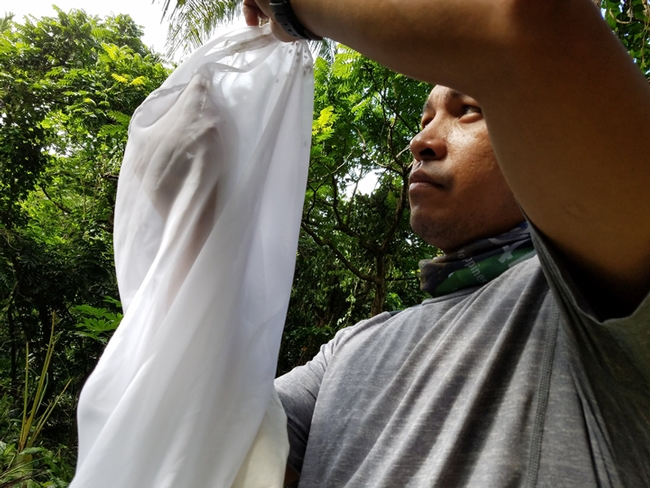
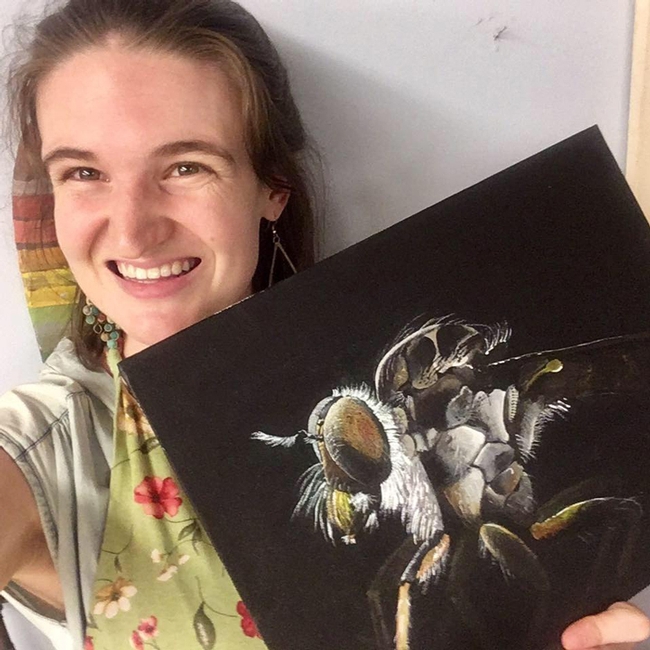
- Author: Kathy Keatley Garvey
Remember that line in Gertrude Stein's 1913 poem, Sacred Emily: "A rose is a rose is a rose"?
Well, to paraphrase Stein: "A bee is a bee is a bee...except when it's not a bee."
In a recent interactive feature in the New York Times, writer Joanna Klein wondered how we can save the bees if we don't recognize them. She asked "Can You Pick the Bees Out of This Insect Lineup?" and posted an image of bees and wanna-be bees.
All entomologists, we're sure, passed. Many others--those who think every floral visitor is a honey bee--probably not.
Bee expert Robbin Thorp, distinguished emeritus professor of entomology at the University of California, Davis, passed it with flying colors--colors that included that gorgeous photo of a metallic green sweat bee. "Photo editors for news articles need to take this test judging by all the images of faux bees that accompany a variety of articles on bees, especially articles designed to educate the public about bees," commented Thorp, who, by the way, is the co-author of Bumble Bees of North America: an Identification Guide (Princeton University Press) and California's Bees and Blooms: a Guide for Gardeners and Naturalists (Heyday). "I suspect that this is what Joe Wilson had in mind when he created the plate of bees and faux bees."
Joseph S. Wilson, as you may recall, co-authored The Bees in Your Backyard: A Guide to North America's Bees (Princeton University Press) with Olivia J. Messenger Carrill. Wilson is also featured in a fantastic TED talk on "Save the Bees! Wait, Was That a Bee?"
Lynn Kimsey, director of the Bohart Museum of Entomology and professor of entomology at UC Davis, gets that a lot--"Is this a bee? Is that a bee?" She recently wrote a piece in the Bohart Museum newsletter about flies masquerading as bees.
Three of the easiest ways to differentiate a fly from a bee:
- A fly has one set of wings. A bee has two sets.
- A fly has short, stubby antennae. A honey bee doesn't.
- A fly has no corbicula or pollen basket. A honey bee (worker bee) does.
A bee is a bee is a bee...except when it's not a bee. Take the New York Times' quiz.
At the end, you'll be asked the number of bee species in the United States. Get ready...
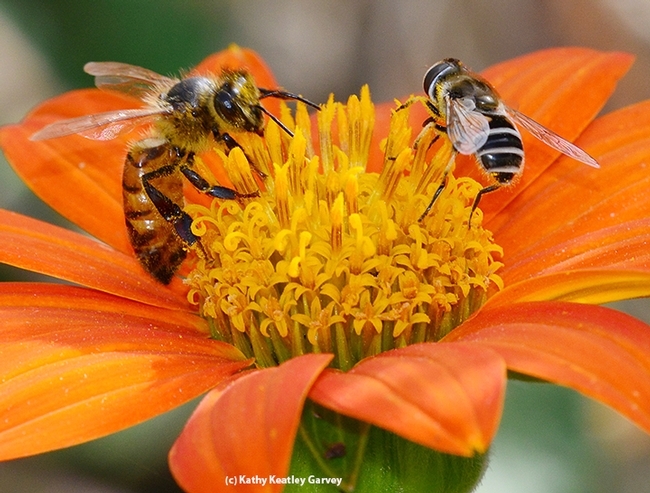
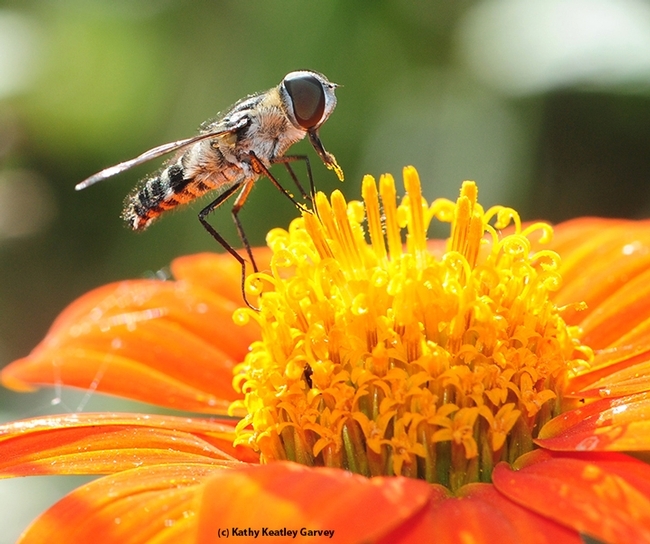
- Author: Kathy Keatley Garvey
If you're walking along the cliffs of Bodega Head, Sonoma County, you may overlook them.
While you're watching for whales, scouting for seabirds and checking out the hikers, there's a lot of movement in the seaside daises (Erigeron glaucus) and seaside woolly sunflower (Eriophyllum staechadifolium).
Green-eyed bullets with spectacular abdominal stripes zero in on the flowers, grab some food (this really is "fast food") and then take off at break-neck speed.
They're sand wasps, Bembix americana, so named because they dig nest holes in the sand. They belong to the family Crabronidae, subfamily Bembicinae, tribe Bembicini (sand wasps), subtribe Bembicina, and genus Bembix. They're quite common in North America. We've seen them from Fort Bragg to Bodega.
They're not vegetarians, like our honey bees. Like all wasps, they're carnivores. They're hunters. They're predators. They prey upon small insects, such as flies. The sand wasps then carry their prey back to their nests.
So while you're watching for whales, watch the flowers. If they move, it may be more than just the wind.
Want to read more about sand wasps? Entomologist Richard Bohart (for whom the Bohart Museum of Entomology at UC Davis, is named), and his former graduate student, Arnold Menke, wrote about them in their book, "Sphecid Wasps of the World," published in 1976 by the University of California Press, Berkeley.
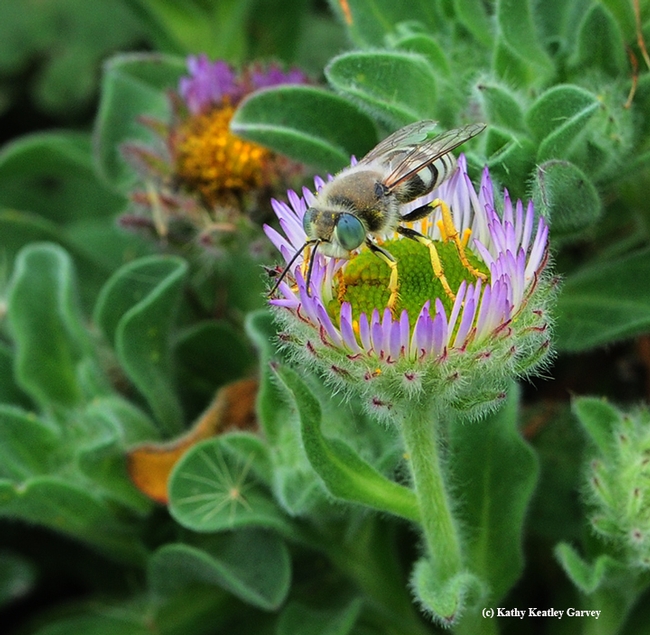
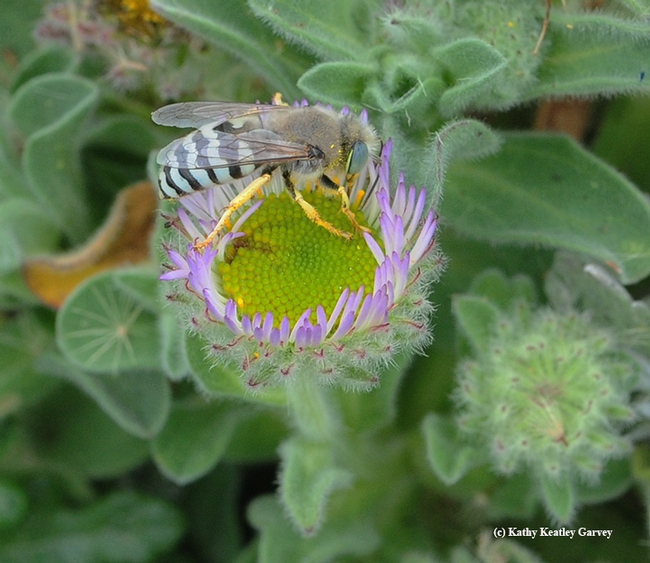
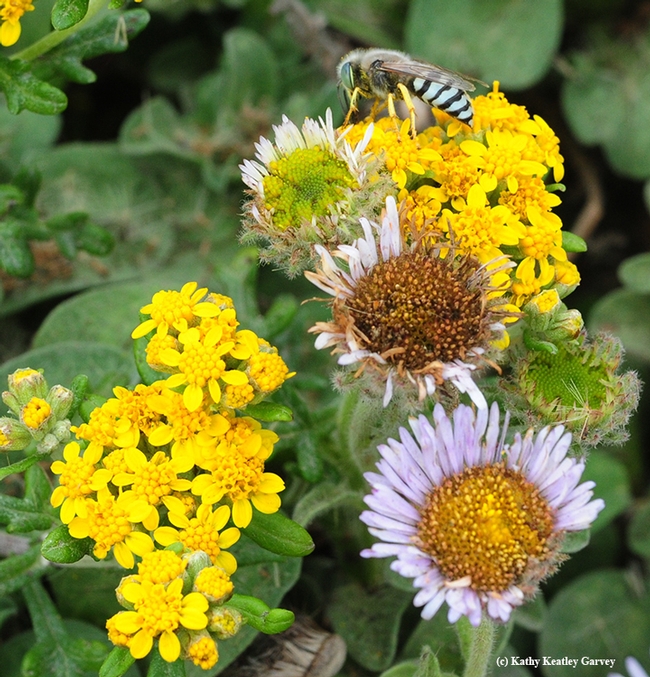
- Author: Kathy Keatley Garvey
What do flies have in common with us?
For one thing, an innate immune system mechanism to detect and fight off invaders that threaten our health.
Four scientists, including two Nobel Laureates, will discuss host defense at a UC Davis symposium on Wednesday, Jan. 25 in the UC Davis Conference Center.
Nobel Laureates Jules Hoffmann of the University of Strasbourg, France and Bruce Beutler of the University of Texas Southwestern Medical Center in Dallas will be among the speakers. They and Rockefeller University researcher Ralph Steinmann (who died in September) shared the 2011 Nobel Prize in Physiology or Medicine for their groundbreaking discoveries concerning the activation of innate immunity.
The symposium, sponsored by the UC Davis Center for Comparative Medicine and the
Murray B. Gardner Research Seminar Fund, will take place from 1 to 5 p.m. Open to all interested persons, it's free but folks must register at http://conferences.ucdavis.edu/immunity to attend.
"In recent years, a remarkable evolutionary conservation of innate immune mechanisms has become apparent between flies, plants, mice and humans," according to the sponsors' flier. "Each of these species uses similar receptors to detect microbes. Therapeutic targeting of toll-like receptors for infectious and inflammatory disease and cancer, and crop engineering of these receptors for resistance to infection, is now a reality."
The Theme
A Symposium on the Evolution of Common Molecular Pathways Underlying Innate Immunity.
The Speakers
"The Drosophila Host Defense: A Model for the Study of Innate Immunity"
--Jules Hoffmann, University of Strasbourg, 2011 Nobel Laureate in Physiology or Medicine
"Creating Immune Deficiencies by Random Mutagenesis in Mammals"
--Bruce Beutler, University of Texas Southwestern Medical Center, Dallas, 2011 Nobel Laureaute in Physiology or Medicine
"The Rice XA21 Receptor Recognizes a Conserved Bacterial Signaling Molecule"
--Pamela Ronald, professor, Department of Plant Pathology, and faculty, UC Davis Genome Center
"Toll-Like Receptors and Inflammasomes: Key Drivers of Inflammatory Diseases"
--Luke O'Neill, professor, School of Biochemistry and Immunology, Trinity College, Dublin
The Contact Person:
Anita Moore at (530) 752-1245.
